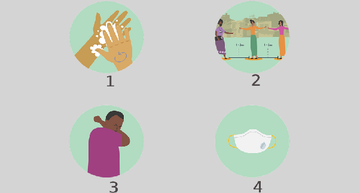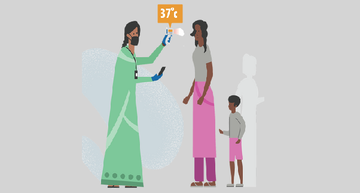Practices to Slow Down the Spread of COVID-19

- Hand hygiene
- Physical distancing
- Respiratory hygiene (i.e. covering nose and mouth when sneezing and coughing)
- Personal Protective equipment (PPE)
It is important to slow the spread of COVID-19 so overburdened health systems can handle the patient load & give severe cases a chance at treatment, if needed. Everyone has a role to play to slow the spread of COVID-19 and needs to help in keeping the number of COVID-19 cases down. Ways to prevent COVID-19 surges include case management, surveillance, contact tracing, vaccine and treatment trials, lab testing, and building support systems.
Isolation vs. Quarantine vs. Physical Distancing
Quarantine is for people who MAY have been exposed to COVID-19, it should be for 14 days to monitor for symptoms and prevent the person from possibly passing COVID-19 to others.
Isolation is for people who HAVE COVID-19 and means they should be separated from other people so they don't pass the virus. They should remain isolated until they are fever free for 3 days.
Physical distance means leaving space between people when you are in public, making it harder for the virus to jump from person to person.
Contact Tracing

Contact Tracing helps to track and stop the spread of COVID-19. It is the process of identifying, assessing and managing people who have been exposed to COVID-19 from a known positive case. Someone is a contact if they were in close contact with a person with COVID-19, such as by touching them, being exposed to body fluids, or attending a gathering together, in the 14 days prior to a person being diagnosed. When a person is diagnosed with COVID-19 you should ask them who they may have been in contact with or where they have been so you can begin to follow up with anyone who may have been exposed.
Once you have identified contacts, you need to screen them for COVID-19. It's important to maintain precautions when doing screenings, such as wearing a mask and washing your hands with soap frequently. When screening people be sure to record their temperature and write down any other symptoms they may have.
Average Rating: ☆ ☆ ☆ ☆ ☆ (0 reviews)


